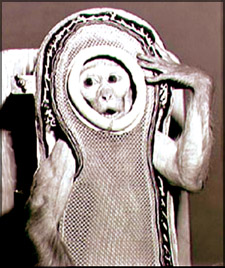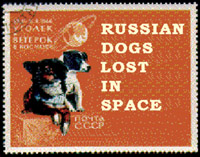The host of animals sent to space
 Can
animals live in outer space? They can't. But there have been various
animals sent to outer space, of course with some life support to test
various aspects. Animals were originally sent to test the ability to
survive space flights before manned space missions were attempted. Can
animals live in outer space? They can't. But there have been various
animals sent to outer space, of course with some life support to test
various aspects. Animals were originally sent to test the ability to
survive space flights before manned space missions were attempted.
Later, animals were flown to
investigate various biological processes and the effects of microgravity
space flights might have on them. Initially, many animals sent out to
space were killed due to hazardous conditions, and these were truly
unfortunate incidents.
Monkeys and dogs are the animals
which were mostly used in these missions. Let's look at the animals
which were sent out to space to educate us humans. You would be
surprised to learn about the large number of animals which have been
sent to space, so far.
Space monkeys
* United States - The United States space programme used many monkeys
initially. They were named Albert I, Albert II, Albert III and so on.
Out of these, Albert II was the first to go into space. However, all
monkeys up to Albert V could not survive.
All of them died on the way except Albert V who died due to a
parachute failure. Albert VI was the first monkey to successfully reach
Earth alive after a journey in a rocket. But, unfortunately it too died
two hours after reaching Earth.
This journey may have been quite exciting since Albert VI had eleven
mice along with him as the crew. This was in 1952. In May, 1959, the two
monkeys Able and Miss Baker became the first living beings to
successfully complete a space journey.
They travelled at speeds of more than 16,000 kilometres per hour.
Able died on June 1, 1959 while undergoing surgery. Miss Baker lived
until November 1984 and died at the age of 27 and is buried on the
grounds of the US Space and Rocket Centre in Huntsville, Alabama.
Until 1985, few other monkeys namely Sam, Miss Sam, Little Joe 1B,
Goliath, Bonny and two squirrel monkeys named No. 3165 and No. 384-80
were sent on missions.
* France - France used
just two monkeys in space tests. They launched a pigtailed macaque named
Martine on a Vesta rocket and another named Pierette in 1967.
* Russia - The Russian
space programme only used Rhesus monkeys and the interesting thing about
their names was that, these monkeys were named in the order of the
Russian Alphabet which goes as A, B, V, G, D, E, Zh, Z, I, K, L, M, and
so on.
Abrek and Bion were in space from December 14, 1983 to December 20,
1983. These monkeys flew on the Bion rockets.
These rockets started as Bion 6, and went up to Bion 11 carrying two
monkeys on each mission. monkey pairs Verny and Gordy, Drema and Yerosha,
Zhakonya and Zabiyaka, Krosh and Ivasha, and Lapik and Multik went on
the missions on Bion rockets. Zhakonya and Zabiyaka hold the record for
surviving 13 days and 17 hours in space.
Space dogs
Dogs were the preferred animal for the experiments because scientists
felt that dogs were better at enduring long periods of being inactive. Stray dogs were selected because they
were believed to have a higher ability to withstand stress.
long periods of being inactive. Stray dogs were selected because they
were believed to have a higher ability to withstand stress.
When it comes to space dogs, the Russian space programme has used
many dogs to send out into space, and they were truly treated as
astronauts. They even appeared on stamps. Laika may be the dog you know
mostly about.
But, you may be surprised to know that there were more than twenty
space dogs in the space missions. These dogs have been used in
sub-orbital flights as well as orbital flights. The dogs Dezik, Tsygan
and Lisa, and Ryzhik, Smelaya and Malyshka, Bolik and ZIB, Otvazhnaya
and Snezhinka are some of the dogs used in sub-orbital flights.
The famous Laika became the first living Earth-born creature in orbit
aboard Sputnik II in 1957. She died between five and seven hours into
the flight from stress and overheating. Her true cause of death was
known only in October 2002. Thereafter, Bars and Lisichka and Belka and
Strelka were sent to orbit.
The mission of Belka and Strelka was really interesting. They had
been accompanied by a grey rabbit, 40 mice, two rats, flies and a number
of plants and fungi. Luckily, all passengers had survived. Other dogs
such as Veterok and Ugolyok, Pchelka and Mushka and few others became
space dogs. China too launched two dogs into space in 1966.
Other space animals
 Apart
from monkeys and dogs, many other creatures have been sent out to space
for testing. Fruit flies have been sent to space in 1946 to test
radiation exposure at high altitudes. Apart
from monkeys and dogs, many other creatures have been sent out to space
for testing. Fruit flies have been sent to space in 1946 to test
radiation exposure at high altitudes.
The Soviet Union in the Vostok 3A flights of March 1961 launched mice
and, for the first time, guinea pigs and frogs. France flew the first
rat into space in 1961 and two more rats were flown in October 1962.
They launched Felix the cat into space in 1963 which had electrodes
implanted into its head to measure neural impulses. China launched mice and rats
in 1964 and 1965. The first tortoise in space was launched in 1968 by
the Soviet Union. Apart from these, other creatures like wasps, frogs,
beetles, spiders, snails, worms and fish were also used in various
tests.
into its head to measure neural impulses. China launched mice and rats
in 1964 and 1965. The first tortoise in space was launched in 1968 by
the Soviet Union. Apart from these, other creatures like wasps, frogs,
beetles, spiders, snails, worms and fish were also used in various
tests.
So, as you can see, a host of animals have been part of the quest of
exploring the unknowns of space. We have known only about a handful.
Aravinda Dassanayake |
